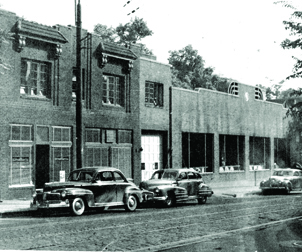Public Screening of Newspaper of Record: The Pittsburgh Courier, 1907-1965 Is Set for March 24
 The former Pittsburgh Courier offices on Centre Avenue in Pittsburgh's Hill District.
The former Pittsburgh Courier offices on Centre Avenue in Pittsburgh's Hill District.The free premier public screening of the 2010 documentary Newspaper of Record: The Pittsburgh Courier, 1907-1965 will be held at 7 p.m. March 24 in the auditorium (Rooms 120-121) of the University of Pittsburgh’s Lawrence Hall.
The documentary received an enthusiastic response at its by-invitation-only world premiere screening on Feb. 1.
During critical periods in our nation’s history, The Pittsburgh Courier weekly newspaper, published between 1907 and 1965, served as an instrument of change in the fight against racial discrimination in housing, jobs, health, education, sports, and other areas. Printed locally but distributed throughout the United States in 14 national editions, The Pittsburgh Courier became the most influential Black newspaper in the nation, with a peak circulation of 400,000. It provided a lens through which Americans could see and read about the gross injustices targeting Blacks, from the Jim Crow era at the beginning of the 20th century through the turbulent years of the civil rights movement. Following the crusading newspaper’s financial collapse in 1965, it soon re-emerged as today’s New Pittsburgh Courier, which continues to serve the community.
Newspaper of Record by filmmaker and University of Pittsburgh alumnus Kenneth Love (A&S ’71) tells the story of the newspaper—how it empowered Blacks across America and helped to reshape national policy. The executive producer of the film, which has been awarded a CINE Golden Eagle for excellence in the visual arts, is Pitt alumnus Barbara McNulty-Love (A&S ’71, MED ’75), who is married to Love.
Newspaper of Record tells its story not only through vintage images and narration, but through interviews with a number of the newspapers’ former editors and reporters. The documentary focuses on the story of how The Courier launched major national campaigns to combat racism, lynching, and race discrimination in education, employment, health, housing, the military, and sports. One of its most famous causes, the “Double V Campaign” of 1942-43, demanded that Blacks fighting for victory in the war abroad win a victory against racism at home as well—through full citizenship rights. The film also includes segments on celebrated Black entertainers, sports figures, and musicians, who were seldom, if ever, covered by the White media; advertising geared specifically to a Black audience; society, style, and fashion columns, which influenced the paper’s women readers; and a range of cartoons, from educational and political to humorous.
Other Stories From This Issue
On the Freedom Road

Follow a group of Pitt students on the Returning to the Roots of Civil Rights bus tour, a nine-day, 2,300-mile journey crisscrossing five states.
Day 1: The Awakening
Day 2: Deep Impressions
Day 3: Music, Montgomery, and More
Day 4: Looking Back, Looking Forward
Day 5: Learning to Remember
Day 6: The Mountaintop
Day 7: Slavery and Beyond
Day 8: Lessons to Bring Home
Day 9: Final Lessons

